Drivers of Last Millennium Antarctic Climate Evolution in an Ensemble of Community Earth System Model Simulations
Abstract
1. Introduction
2. Methods and Data
2.1. Community Earth System Model—Last Millennium Ensemble (CESM-LME)
2.2. Paleoclimate Records
3. Results
3.1. Full Forcing Simulations
3.2. Single Forcing Simulations
4. Discussion
4.1. Drivers of Antarctic Temperature Evolution in the CESM-LME
4.2. Polar Asymmetry
4.3. Comparison to Proxy Records
4.4. Role of Large-Scale Modes of Climate Variability (SAM and ENSO)
4.5. Considerations When Comparing Paleoclimate Records and Model Simulations
5. Conclusions
Supplementary Materials
Author Contributions
Funding
Institutional Review Board Statement
Informed Consent Statement
Data Availability Statement
Acknowledgments
Conflicts of Interest
References
- Nicolas, J.P.; Bromwich, D.H. New Reconstruction of Antarctic Near-Surface Temperatures: Multidecadal Trends and Reliability of Global Reanalyses. J. Clim. 2014, 27, 8070–8093. [Google Scholar] [CrossRef]
- Bromwich, D.H.; Nicolas, J.P.; Monaghan, A.J.; Lazzara, M.A.; Keller, L.M.; Weidner, G.A.; Wilson, A.B. Central West Antarctica among the Most Rapidly Warming Regions on Earth. Nat. Geosci. 2013, 6, 139–145. [Google Scholar] [CrossRef]
- Ding, Q.; Steig, E.J.; Battisti, D.S.; Küttel, M. Winter Warming in West Antarctica Caused by Central Tropical Pacific Warming. Nat. Geosci. 2011, 4, 398–403. [Google Scholar] [CrossRef]
- Hsu, P.-C.; Fu, Z.; Murakami, H.; Lee, J.-Y.; Yoo, C.; Johnson, N.C.; Chang, C.-H.; Liu, Y. East Antarctic Cooling Induced by Decadal Changes in Madden-Julian Oscillation during Austral Summer. Sci. Adv. 2021, 7, eabf9903. [Google Scholar] [CrossRef] [PubMed]
- Steig, E.; Ding, Q.; Battisti, D.; Jenkins, A. Tropical Forcing of Circumpolar Deep Water Inflow and Outlet Glacier Thinning in the Amundsen Sea Embayment, West Antarctica. Ann. Glaciol. 2012, 53, 19–28. [Google Scholar] [CrossRef]
- Turner, J.; Lu, H.; White, I.; King, J.C.; Phillips, T.; Hosking, J.S.; Bracegirdle, T.J.; Marshall, G.J.; Mulvaney, R.; Deb, P. Absence of 21st Century Warming on Antarctic Peninsula Consistent with Natural Variability. Nature 2016, 535, 411–415. [Google Scholar] [CrossRef] [PubMed]
- Jones, J.M.; Gille, S.T.; Goosse, H.; Abram, N.J.; Canziani, P.O.; Charman, D.J.; Clem, K.R.; Crosta, X.; de Lavergne, C.; Eisenman, I.; et al. Assessing Recent Trends in High-Latitude Southern Hemisphere Surface Climate. Nat. Clim. Chang. 2016, 6, 917–926. [Google Scholar] [CrossRef]
- Beadling, R.L.; Russell, J.L.; Stouffer, R.J.; Mazloff, M.; Talley, L.D.; Goodman, P.J.; Sallée, J.B.; Hewitt, H.T.; Hyder, P.; Pandde, A. Representation of Southern Ocean Properties across Coupled Model Intercomparison Project Generations: CMIP3 to CMIP6. J. Clim. 2020, 33, 6555–6581. [Google Scholar] [CrossRef]
- Neukom, R.; Barboza, L.A.; Erb, M.P.; Shi, F.; Emile-Geay, J.; Evans, M.N.; Franke, J.; Kaufman, D.S.; Lücke, L.; Rehfeld, K.; et al. Consistent Multidecadal Variability in Global Temperature Reconstructions and Simulations over the Common Era. Nat. Geosci. 2019, 12, 643–649. [Google Scholar] [CrossRef]
- Diaz, H.F.; Trigo, R.; Hughes, M.K.; Mann, M.E.; Xoplaki, E.; Barriopedro, D. Spatial and Temporal Characteristics of Climate in Medieval Times Revisited. Bull. Am. Meteorol. Soc. 2011, 92, 1487–1500. [Google Scholar] [CrossRef]
- Mann, M.E.; Zhang, Z.; Rutherford, S.; Bradley, R.S.; Hughes, M.K.; Shindell, D.; Ammann, C.; Faluvegi, G.; Ni, F. Global Signatures and Dynamical Origins of the Little Ice Age and Medieval Climate Anomaly. Science 2009, 326, 1256–1260. [Google Scholar] [CrossRef]
- Bertler, N.A.N.; Mayewski, P.A.; Carter, L. Cold Conditions in Antarctica during the Little Ice Age—Implications for Abrupt Climate Change Mechanisms. Earth Planet. Sci. Lett. 2011, 308, 41–51. [Google Scholar] [CrossRef]
- Lüning, S.; Gałka, M.; Vahrenholt, F. The Medieval Climate Anomaly in Antarctica. Palaeogeogr. Palaeoclimatol. Palaeoecol. 2019, 532, 109251. [Google Scholar] [CrossRef]
- Orsi, A.J.; Cornuelle, B.D.; Severinghaus, J.P. Little Ice Age Cold Interval in West Antarctica: Evidence from Borehole Temperature at the West Antarctic Ice Sheet (WAIS) Divide. Geophys. Res. Lett. 2012, 39, L09710. [Google Scholar] [CrossRef]
- Rhodes, R.H.; Bertler, N.A.N.; Baker, J.A.; Steen-Larsen, H.C.; Sneed, S.B.; Morgenstern, U.; Johnsen, S.J. Little Ice Age Climate and Oceanic Conditions of the Ross Sea, Antarctica from a Coastal Ice Core Record. Clim. Past 2012, 8, 1223–1238. [Google Scholar] [CrossRef]
- Simms, A.R.; Bentley, M.J.; Simkins, L.M.; Zurbuchen, J.; Reynolds, L.C.; DeWitt, R.; Thomas, E.R. Evidence for a “Little Ice Age” Glacial Advance within the Antarctic Peninsula—Examples from Glacially-Overrun Raised Beaches. Quat. Sci. Rev. 2021, 271, 107195. [Google Scholar] [CrossRef]
- Wang, J.; Emile-Geay, J.; Guillot, D.; McKay, N.P.; Rajaratnam, B. Fragility of Reconstructed Temperature Patterns over the Common Era: Implications for Model Evaluation. Geophys. Res. Lett. 2015, 42, 7162–7170. [Google Scholar] [CrossRef]
- Neukom, R.; Steiger, N.; Gómez-Navarro, J.J.; Wang, J.; Werner, J.P. No Evidence for Globally Coherent Warm and Cold Periods over the Preindustrial Common Era. Nature 2019, 571, 550–554. [Google Scholar] [CrossRef]
- Perkins, W.; Hakim, G. Coupled Atmosphere-Ocean Reconstruction of the Last Millennium Using Online Data Assimilation. Paleoceanogr. Paleoclimatol. 2021, 36, e2020PA003959. [Google Scholar] [CrossRef]
- An, C.; Hou, S.; Jiang, S.; Li, Y.; Ma, T.; Curran, M.A.J.; Pang, H.; Zhang, Z.; Zhang, W.; Yu, J.; et al. The Long-Term Cooling Trend in East Antarctic Plateau Over the Past 2000 Years Is Only Robust Between 550 and 1550 CE. Geophys. Res. Lett. 2021, 48, e2021GL092923. [Google Scholar] [CrossRef]
- Bertler, N.A.N.; Conway, H.; Dahl-Jensen, D.; Emanuelsson, D.B.; Winstrup, M.; Vallelonga, P.T.; Lee, J.E.; Brook, E.J.; Severinghaus, J.P.; Fudge, T.J.; et al. The Ross Sea Dipole—Temperature, Snow Accumulation and Sea Ice Variability in the Ross Sea Region, Antarctica, over the Past 2700 Years. Clim. Past 2018, 14, 193–214. [Google Scholar] [CrossRef]
- Mulvaney, R.; Abram, N.J.; Hindmarsh, R.C.A.; Arrowsmith, C.; Fleet, L.; Triest, J.; Sime, L.C.; Alemany, O.; Foord, S. Recent Antarctic Peninsula Warming Relative to Holocene Climate and Ice-Shelf History. Nature 2012, 489, 141–144. [Google Scholar] [CrossRef]
- Stenni, B.; Curran, M.A.J.; Abram, N.J.; Orsi, A.; Goursaud, S.; Masson-Delmotte, V.; Neukom, R.; Goosse, H.; Divine, D.; van Ommen, T.; et al. Antarctic Climate Variability on Regional and Continental Scales over the Last 2000 Years. Clim. Past 2017, 13, 1609–1634. [Google Scholar] [CrossRef]
- PAGES 2k-PMIP3 group Continental-Scale Temperature Variability in PMIP3 Simulations and PAGES 2k Regional Temperature Reconstructions over the Past Millennium. Clim. Past 2015, 11, 1673–1699. [CrossRef]
- Miller, G.H.; Geirsdóttir, Á.; Zhong, Y.; Larsen, D.J.; Otto-Bliesner, B.L.; Holland, M.M.; Bailey, D.A.; Refsnider, K.A.; Lehman, S.J.; Southon, J.R.; et al. Abrupt Onset of the Little Ice Age Triggered by Volcanism and Sustained by Sea-Ice/Ocean Feedbacks. Geophys. Res. Lett. 2012, 39, L02708. [Google Scholar] [CrossRef]
- Slawinska, J.; Robock, A. Impact of Volcanic Eruptions on Decadal to Centennial Fluctuations of Arctic Sea Ice Extent during the Last Millennium and on Initiation of the Little Ice Age. J. Clim. 2018, 31, 2145–2167. [Google Scholar] [CrossRef]
- Tavernier, I.; Verleyen, E.; Hodgson, D.A.; Heirman, K.; Roberts, S.J.; Imura, S.; Kudoh, S.; Sabbe, K.; De Batist, M.; Vyverman, W. Absence of a Medieval Climate Anomaly, Little Ice Age and Twentieth Century Warming in Skarvsnes, Lützow Holm Bay, East Antarctica. Antart. Sci. 2014, 26, 585–598. [Google Scholar] [CrossRef][Green Version]
- Ahmed, M.; Anchukaitis, K.J.; Asrat, A.; Borgaonkar, H.P.; Braida, M.; Buckley, B.M.; Büntgen, U.; Chase, B.M.; Christie, D.A.; Cook, E.R.; et al. Continental-Scale Temperature Variability during the Past Two Millennia. Nat. Geosci. 2013, 6, 339–346. [Google Scholar] [CrossRef]
- Goosse, H.; Braida, M.; Crosta, X.; Mairesse, A.; Masson-Delmotte, V.; Mathiot, P.; Neukom, R.; Oerter, H.; Philippon, G.; Renssen, H.; et al. Antarctic Temperature Changes during the Last Millennium: Evaluation of Simulations and Reconstructions. Quat. Sci. Rev. 2012, 55, 75–90. [Google Scholar] [CrossRef]
- Tonelli, M.; Marcello, F.; Ferrero, B.; Wainer, I. Warm Deep Water Variability During the Last Millennium in the CESM–LME: Pre-Industrial Scenario versus Late 20th Century Changes. Geosciences 2019, 9, 346. [Google Scholar] [CrossRef]
- Wainer, I.; Gent, P.R. Changes in the Atlantic Sector of the Southern Ocean Estimated from the CESM Last Millennium Ensemble. Antarct. Sci. 2019, 31, 37–51. [Google Scholar] [CrossRef]
- Silvestri, G.; Berman, A.L.; De Vleeschouwer, F.; Wainer, I. Last Millennium Climate Changes over the Antarctic Peninsula and Southern Patagonia in CESM-LME Simulations: Differences between Medieval Climate Anomaly and Present-Day Temperatures. Quat. Sci. Rev. 2021, 274, 107273. [Google Scholar] [CrossRef]
- Marcello, F.; Wainer, I.; Gent, P.R.; Otto-Bliesner, B.L.; Brady, E.C. South Atlantic Surface Boundary Current System during the Last Millennium in the CESM-LME: The Medieval Climate Anomaly and Little Ice Age. Geosciences 2019, 9, 299. [Google Scholar] [CrossRef]
- Owens, M.J.; Lockwood, M.; Hawkins, E.; Usoskin, I.; Jones, G.S.; Barnard, L.; Schurer, A.; Fasullo, J. The Maunder Minimum and the Little Ice Age: An Update from Recent Reconstructions and Climate Simulations. J. Space Weather Space Clim. 2017, 7, A33. [Google Scholar] [CrossRef]
- Stevenson, S.; Otto-Bliesner, B.; Fasullo, J.; Brady, E. “El Niño Like” Hydroclimate Responses to Last Millennium Volcanic Eruptions. J. Clim. 2016, 29, 2907–2921. [Google Scholar] [CrossRef]
- Stevenson, S.; Otto-Bliesner, B.L.; Brady, E.C.; Nusbaumer, J.; Tabor, C.; Tomas, R.; Noone, D.C.; Liu, Z. Volcanic Eruption Signatures in the Isotope-Enabled Last Millennium Ensemble. Paleoceanogr. Paleoclimatol. 2019, 34, 1534–1552. [Google Scholar] [CrossRef]
- Fasullo, J.T.; Otto-Bliesner, B.L.; Stevenson, S. The Influence of Volcanic Aerosol Meridional Structure on Monsoon Responses over the Last Millennium. Geophys. Res. Lett. 2019, 46, 12350–12359. [Google Scholar] [CrossRef]
- Hurrell, J.W.; Holland, M.M.; Gent, P.R.; Ghan, S.; Kay, J.E.; Kushner, P.J.; Lamarque, J.-F.; Large, W.G.; Lawrence, D.; Lindsay, K.; et al. The Community Earth System Model: A Framework for Collaborative Research. Bull. Amer. Meteor. Soc. 2013, 94, 1339–1360. [Google Scholar] [CrossRef]
- Barthel, A.; Agosta, C.; Little, C.M.; Hattermann, T.; Jourdain, N.C.; Goelzer, H.; Nowicki, S.; Seroussi, H.; Straneo, F.; Bracegirdle, T.J. CMIP5 Model Selection for ISMIP6 Ice Sheet Model Forcing: Greenland and Antarctica. Cryosphere 2020, 14, 855–879. [Google Scholar] [CrossRef]
- Fasullo, J.T. Evaluating Simulated Climate Patterns from the CMIP Archives Using Satellite and Reanalysis Datasets Using the Climate Model Assessment Tool (CMATv1). Geosci. Model Dev. 2020, 13, 3627–3642. [Google Scholar] [CrossRef]
- Otto-Bliesner, B.L.; Brady, E.C.; Fasullo, J.; Jahn, A.; Landrum, L.; Stevenson, S.; Rosenbloom, N.; Mai, A.; Strand, G. Climate Variability and Change since 850 CE: An Ensemble Approach with the Community Earth System Model. Bull. Amer. Meteor. Soc. 2015, 97, 735–754. [Google Scholar] [CrossRef]
- Gao, C.; Robock, A.; Ammann, C. Volcanic Forcing of Climate over the Past 1500 Years: An Improved Ice Core-Based Index for Climate Models. J. Geophys. Res. 2008, 113, D23111. [Google Scholar] [CrossRef]
- Vieira, L.E.A.; Solanki, S.K.; Krivova, N.A.; Usoskin, I. Evolution of the Solar Irradiance during the Holocene. Astron. Astrophys. 2011, 531, A6. [Google Scholar] [CrossRef]
- Schmidt, G.A.; Jungclaus, J.H.; Ammann, C.M.; Bard, E.; Braconnot, P.; Crowley, T.J.; Delaygue, G.; Joos, F.; Krivova, N.A.; Muscheler, R.; et al. Climate Forcing Reconstructions for Use in PMIP Simulations of the Last Millennium (v1.0). Geosci. Model Dev. 2011, 4, 33–45. [Google Scholar] [CrossRef]
- Pongratz, J.; Reick, C.; Raddatz, T.; Claussen, M. A Reconstruction of Global Agricultural Areas and Land Cover for the Last Millennium: Millenium land cover reconstruction. Glob. Biogeochem. Cycles 2008, 22. [Google Scholar] [CrossRef]
- Hurtt, G.C.; Chini, L.P.; Frolking, S.; Betts, R.A.; Feddema, J.; Fischer, G.; Fisk, J.P.; Hibbard, K.; Houghton, R.A.; Janetos, A.; et al. Harmonization of Land-Use Scenarios for the Period 1500–2100: 600 Years of Global Gridded Annual Land-Use Transitions, Wood Harvest, and Resulting Secondary Lands. Clim. Chang. 2011, 109, 117–161. [Google Scholar] [CrossRef]
- Berger, A. Long-Term Variations of Daily Insolation and Quaternary Climatic Changes. J. Atmos. Sci. 1978, 35, 2362–2367. [Google Scholar] [CrossRef]
- Phillips, A.; Deser, C.; Fasullo, J.; Schneider, D.P.; Simpson, I.R. Assessing Climate Variability and Change in Model Large Ensembles: A User’s Guide to the “Climate Variability Diagnostics Package for Large Ensembles”. 2020. Available online: https://opensky.ucar.edu/islandora/object/manuscripts:1001 (accessed on 31 May 2022).
- Gupta, A.S.; Jourdain, N.C.; Brown, J.N.; Monselesan, D. Climate Drift in the CMIP5 Models. J. Clim. 2013, 26, 8597–8615. [Google Scholar] [CrossRef]
- Lücke, L.J.; Schurer, A.P.; Wilson, R.; Hegerl, G.C. Orbital Forcing Strongly Influences Seasonal Temperature Trends During the Last Millennium. Geophys. Res. Lett. 2021, 48, e2020GL088776. [Google Scholar] [CrossRef]
- Manabe, S.; Stouffer, R.J. Low-Frequency Variability of Surface Air Temperature in a 1000-Year Integration of a Coupled Atmosphere-Ocean-Land Surface Model. J. Clim. 1996, 9, 376–393. [Google Scholar] [CrossRef]
- Tsai, C.-Y.; Forest, C.E.; Pollard, D. The Role of Internal Climate Variability in Projecting Antarctica’s Contribution to Future Sea-Level Rise. Clim. Dyn. 2020, 55, 1875–1892. [Google Scholar] [CrossRef]
- Verona, L.S.; Wainer, I.; Stevenson, S. Volcanically Triggered Ocean Warming Near the Antarctic Peninsula. Sci. Rep. 2019, 9, 9462. [Google Scholar] [CrossRef] [PubMed]
- Siedler, G.; Church, J.; Gould, J. (Eds.) Ocean Circulation and Climate: Observing and Modelling the Global Ocean; This is Volume 77 in the International Geophysics Series; Academic Press: San Diego, CA, USA, 2001; ISBN 978-0-12-641351-9. [Google Scholar]
- Manabe, S.; Stouffer, R.J. Sensitivity of a Global Climate Model to an Increase of CO 2 Concentration in the Atmosphere. J. Geophys. Res. 1980, 85, 5529. [Google Scholar] [CrossRef]
- Singh, H.A.; Garuba, O.A.; Rasch, P.J. How Asymmetries Between Arctic and Antarctic Climate Sensitivity Are Modified by the Ocean. Geophys. Res. Lett. 2018, 45, 13031–13040. [Google Scholar] [CrossRef]
- Nghiem, S.V.; Rigor, I.G.; Clemente-Colón, P.; Neumann, G.; Li, P.P. Geophysical Constraints on the Antarctic Sea Ice Cover. Remote Sens. Environ. 2016, 181, 281–292. [Google Scholar] [CrossRef]
- Sterken, M.; Roberts, S.J.; Hodgson, D.A.; Vyverman, W.; Balbo, A.L.; Sabbe, K.; Moreton, S.G.; Verleyen, E. Holocene Glacial and Climate History of Prince Gustav Channel, Northeastern Antarctic Peninsula. Quat. Sci. Rev. 2012, 31, 93–111. [Google Scholar] [CrossRef]
- Dickens, W.A.; Kuhn, G.; Leng, M.J.; Graham, A.G.C.; Dowdeswell, J.A.; Meredith, M.P.; Hillenbrand, C.-D.; Hodgson, D.A.; Roberts, S.J.; Sloane, H.; et al. Enhanced Glacial Discharge from the Eastern Antarctic Peninsula since the 1700s Associated with a Positive Southern Annular Mode. Sci. Rep. 2019, 9, 14606. [Google Scholar] [CrossRef] [PubMed]
- Neukom, R.; Schurer, A.P.; Steiger, N.J.; Hegerl, G.C. Possible Causes of Data Model Discrepancy in the Temperature History of the Last Millennium. Sci. Rep. 2018, 8, 7572. [Google Scholar] [CrossRef]
- Abram, N.J.; Mulvaney, R.; Vimeux, F.; Phipps, S.J.; Turner, J.; England, M.H. Evolution of the Southern Annular Mode during the Past Millennium. Nat. Clim. Chang. 2014, 4, 564–569. [Google Scholar] [CrossRef]
- Klein, F.; Abram, N.J.; Curran, M.A.J.; Goosse, H.; Goursaud, S.; Masson-Delmotte, V.; Moy, A.; Neukom, R.; Orsi, A.; Sjolte, J.; et al. Assessing the Robustness of Antarctic Temperature Reconstructions over the Past 2 Millennia Using Pseudoproxy and Data Assimilation Experiments. Clim. Past 2019, 15, 661–684. [Google Scholar] [CrossRef]
- Pauling, A.G.; Bushuk, M.; Bitz, C.M. Robust Inter-Hemispheric Asymmetry in the Response to Symmetric Volcanic Forcing in Model Large Ensembles. Geophys. Res. Lett. 2021, 48, e2021GL092558. [Google Scholar] [CrossRef]
- Zanchettin, D.; Bothe, O.; Timmreck, C.; Bader, J.; Beitsch, A.; Graf, H.-F.; Notz, D.; Jungclaus, J.H. Inter-Hemispheric Asymmetry in the Sea-Ice Response to Volcanic Forcing Simulated by MPI-ESM (COSMOS-Mill). Earth Syst. Dynam. 2014, 5, 223–242. [Google Scholar] [CrossRef]
- Tardif, R.; Hakim, G.J.; Perkins, W.A.; Horlick, K.A.; Erb, M.P.; Emile-Geay, J.; Anderson, D.M.; Steig, E.J.; Noone, D. Last Millennium Reanalysis with an Expanded Proxy Database and Seasonal Proxy Modeling. Clim. Past 2019, 15, 1251–1273. [Google Scholar] [CrossRef]
- Landrum, L.; Otto-Bliesner, B.L.; Wahl, E.R.; Conley, A.; Lawrence, P.J.; Rosenbloom, N.; Teng, H. Last Millennium Climate and Its Variability in CCSM4. J. Clim. 2013, 26, 1085–1111. [Google Scholar] [CrossRef]
- Dätwyler, C.; Neukom, R.; Abram, N.J.; Gallant, A.J.E.; Grosjean, M.; Jacques-Coper, M.; Karoly, D.J.; Villalba, R. Teleconnection Stationarity, Variability and Trends of the Southern Annular Mode (SAM) during the Last Millennium. Clim. Dyn. 2018, 51, 2321–2339. [Google Scholar] [CrossRef]
- Perren, B.B.; Hodgson, D.A.; Roberts, S.J.; Sime, L.; Van Nieuwenhuyze, W.; Verleyen, E.; Vyverman, W. Southward Migration of the Southern Hemisphere Westerly Winds Corresponds with Warming Climate over Centennial Timescales. Commun. Earth Environ. 2020, 1, 1–8. [Google Scholar] [CrossRef]
- Villalba, R.; Lara, A.; Masiokas, M.H.; Urrutia, R.; Luckman, B.H.; Marshall, G.J.; Mundo, I.A.; Christie, D.A.; Cook, E.R.; Neukom, R.; et al. Unusual Southern Hemisphere Tree Growth Patterns Induced by Changes in the Southern Annular Mode. Nat. Geosci. 2012, 5, 793–798. [Google Scholar] [CrossRef]
- Mo, K.C.; Paegle, J.N. The Pacific—South American Modes and Their Downstream Effects. Int. J. Climatol. 2001, 21, 1211–1229. [Google Scholar] [CrossRef]
- Ljungqvist, F.C.; Zhang, Q.; Brattström, G.; Krusic, P.J.; Seim, A.; Li, Q.; Zhang, Q.; Moberg, A. Centennial-Scale Temperature Change in Last Millennium Simulations and Proxy-Based Reconstructions. J. Clim. 2019, 32, 2441–2482. [Google Scholar] [CrossRef]
- Neukom, R.; Gergis, J.; Karoly, D.J.; Wanner, H.; Curran, M.; Elbert, J.; González-Rouco, F.; Linsley, B.K.; Moy, A.D.; Mundo, I.; et al. Inter-Hemispheric Temperature Variability over the Past Millennium. Nat. Clim. Chang. 2014, 4, 362–367. [Google Scholar] [CrossRef]
- Parsons, L.A.; Loope, G.R.; Overpeck, J.T.; Ault, T.R.; Stouffer, R.; Cole, J.E. Temperature and Precipitation Variance in CMIP5 Simulations and Paleoclimate Records of the Last Millennium. J. Clim. 2017, 30, 8885–8912. [Google Scholar] [CrossRef]
- Roldán-Gómez, P.J.; González-Rouco, J.F.; Melo-Aguilar, C.; Smerdon, J.E. Dynamical and Hydrological Changes in Climate Simulations of the Last Millennium. Clim. Past 2020, 16, 1285–1307. [Google Scholar] [CrossRef]
- Meehl, G.A.; Arblaster, J.M.; Matthes, K.; Sassi, F.; van Loon, H. Amplifying the Pacific Climate System Response to a Small 11-Year Solar Cycle Forcing. Science 2009, 325, 1114–1118. [Google Scholar] [CrossRef]
- Henke, L.M.K.; Lambert, F.H.; Charman, D.J. Was the Little Ice Age More or Less El Niño-like than the Medieval Climate Anomaly? Evidence from Hydrological and Temperature Proxy Data. Clim. Past 2017, 13, 267–301. [Google Scholar] [CrossRef]
- Kravtsov, S.; Grimm, C.; Gu, S. Global-Scale Multidecadal Variability Missing in State-of-the-Art Climate Models. npj Clim. Atmos. Sci. 2018, 1, 34. [Google Scholar] [CrossRef]
- Jüling, A.; von der Heydt, A.; Dijkstra, H.A. Effects of Strongly Eddying Oceans on Multidecadal Climate Variability in the Community Earth System Model. Ocean. Sci. 2021, 17, 1251–1271. [Google Scholar] [CrossRef]
- Cheung, A.H.; Mann, M.E.; Steinman, B.A.; Frankcombe, L.M.; England, M.H.; Miller, S.K. Comparison of Low-Frequency Internal Climate Variability in CMIP5 Models and Observations. J. Clim. 2017, 30, 4763–4776. [Google Scholar] [CrossRef]
- Mann, M.E.; Steinman, B.A.; Miller, S.K. Absence of Internal Multidecadal and Interdecadal Oscillations in Climate Model Simulations. Nat. Commun. 2020, 11, 49. [Google Scholar] [CrossRef]
- Maycock, A.C.; Ineson, S.; Gray, L.J.; Scaife, A.A.; Anstey, J.A.; Lockwood, M.; Butchart, N.; Hardiman, S.C.; Mitchell, D.M.; Osprey, S.M. Possible Impacts of a Future Grand Solar Minimum on Climate: Stratospheric and Global Circulation Changes. J. Geophys. Res. Atmos. 2015, 120, 9043–9058. [Google Scholar] [CrossRef] [PubMed]
- Matthes, K.; Funke, B.; Andersson, M.E.; Barnard, L.; Beer, J.; Charbonneau, P.; Clilverd, M.A.; de Wit, T.D.; Haberreiter, M.; Hendry, A.; et al. Solar Forcing for CMIP6 (v3.2). Geosci. Model Dev. 2017, 10, 2247–2302. [Google Scholar] [CrossRef]
- Wright, N.M.; Krause, C.E.; Phipps, S.J.; Boschat, G.; Abram, N.J. Influence of Long-Term Changes in Solar Irradiance Forcing on the Southern Annular Mode. Clim. Past 2022, 18, 1509–1528. [Google Scholar] [CrossRef]
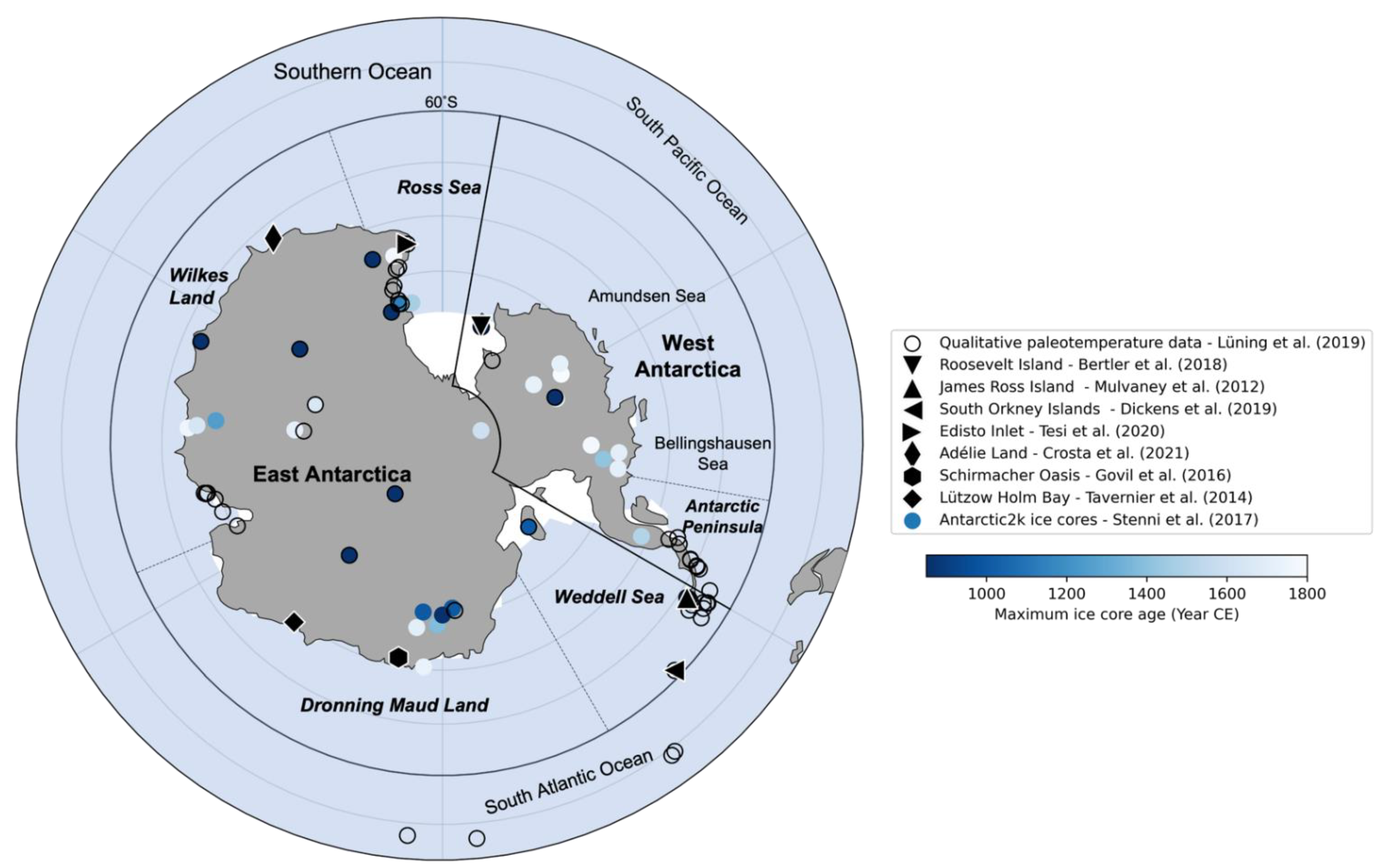
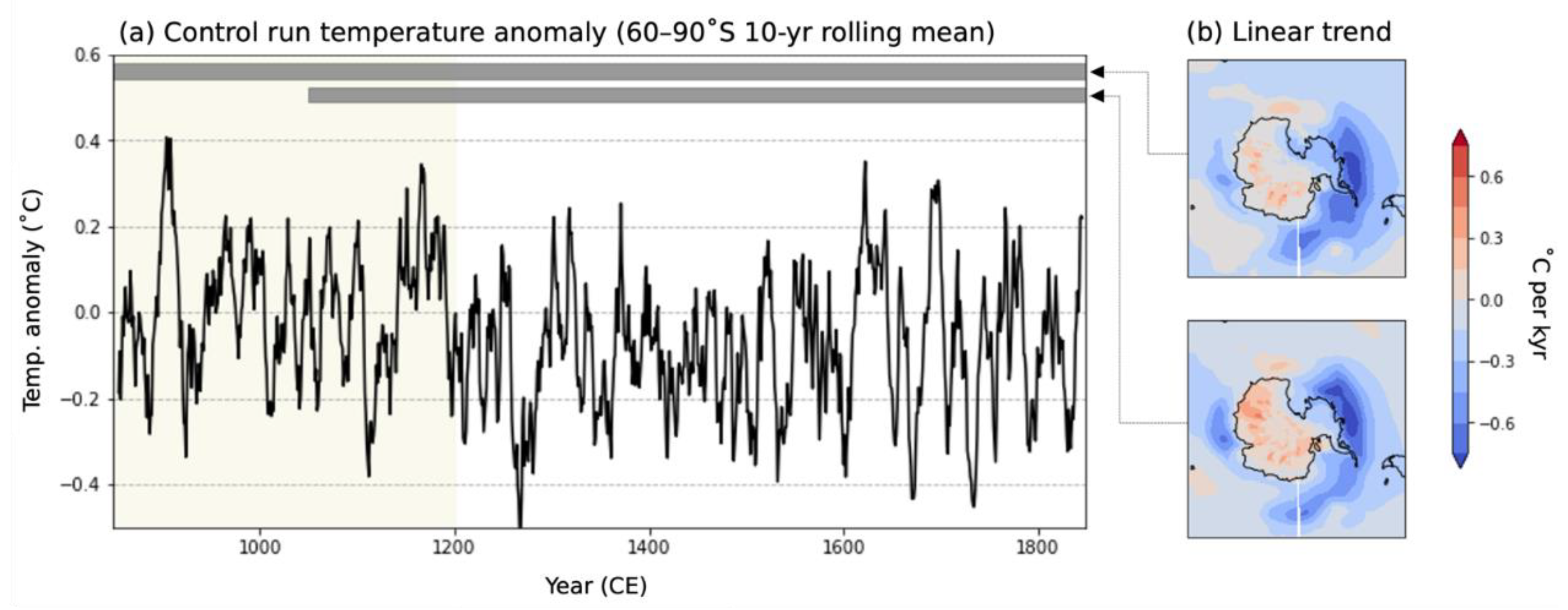
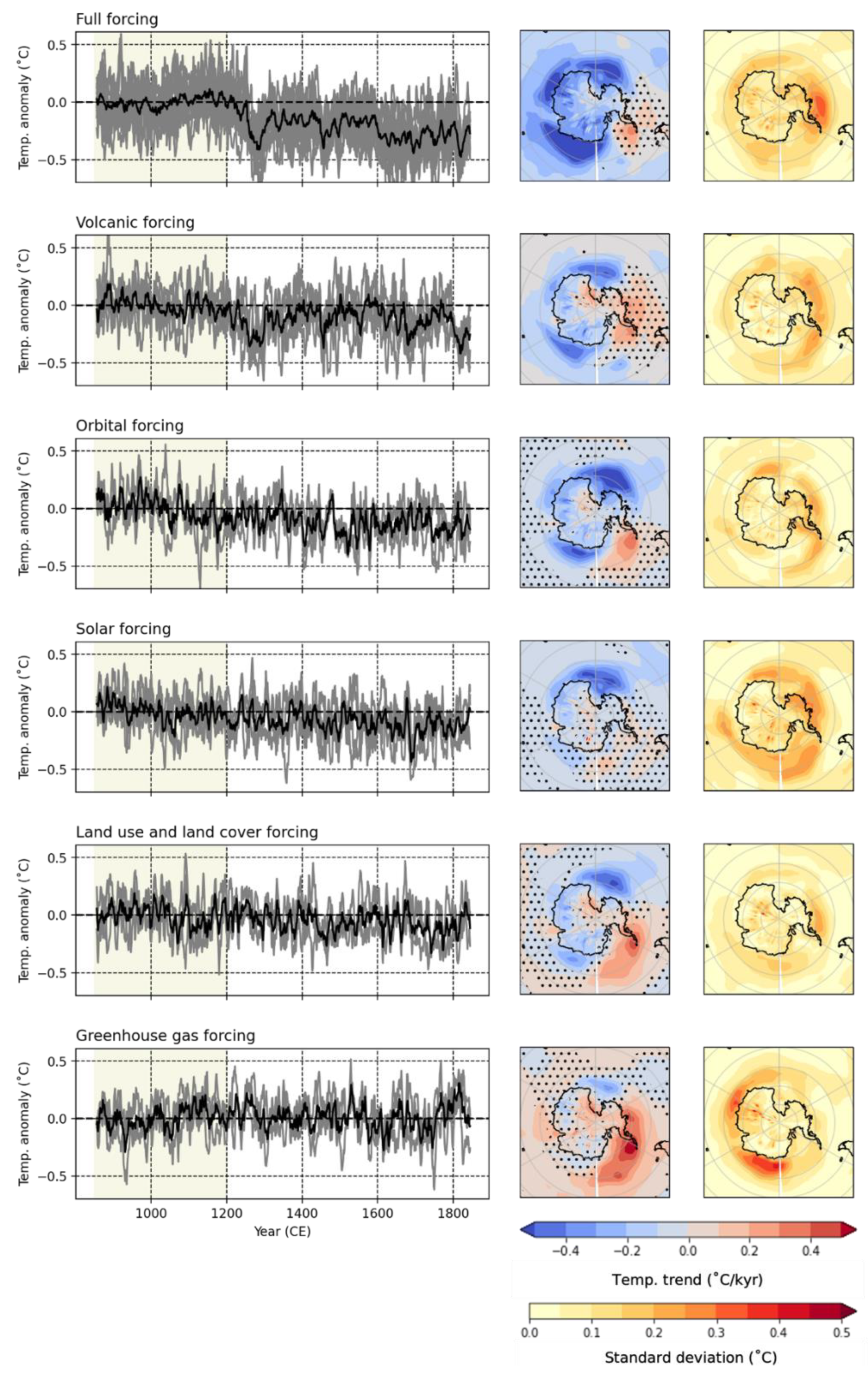

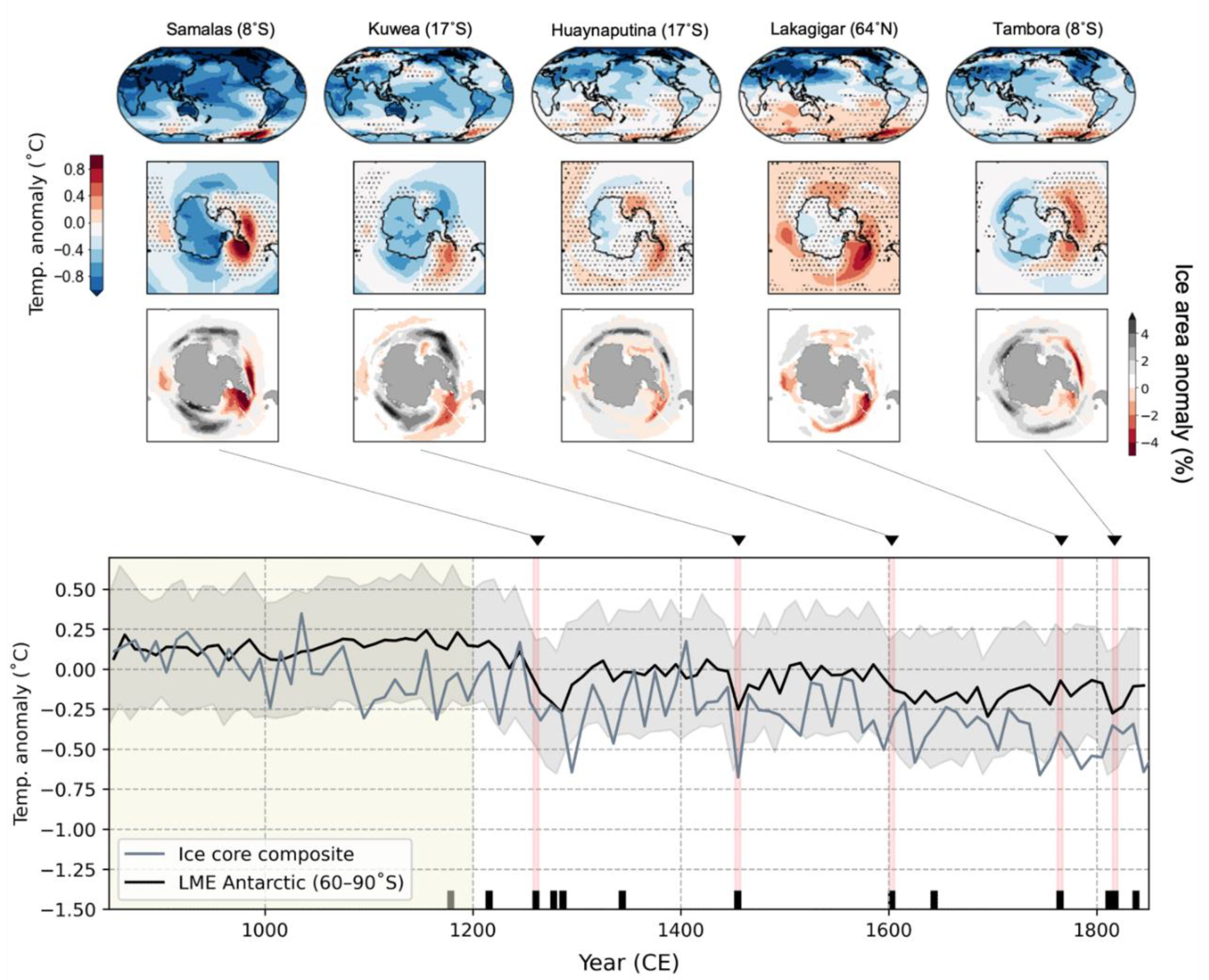

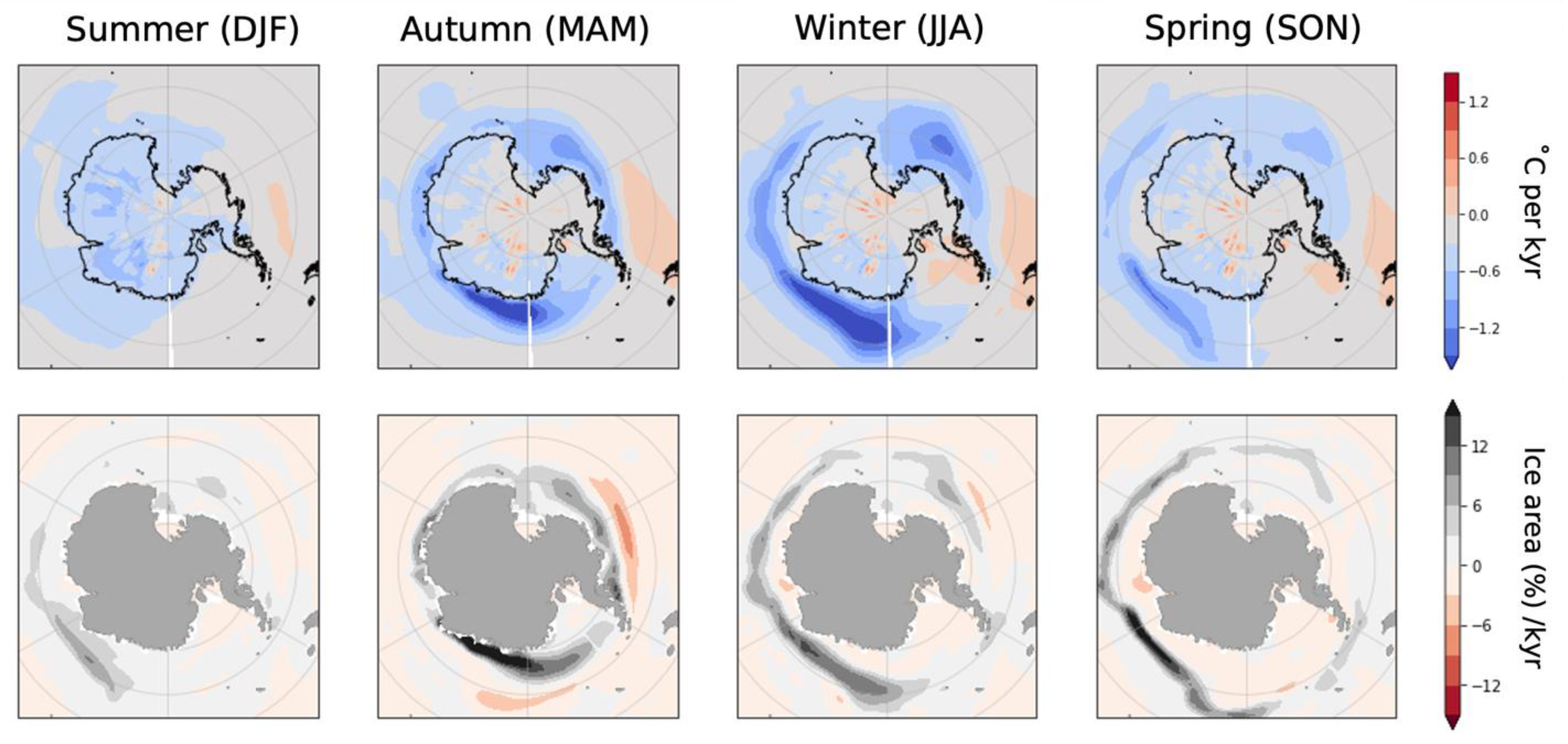
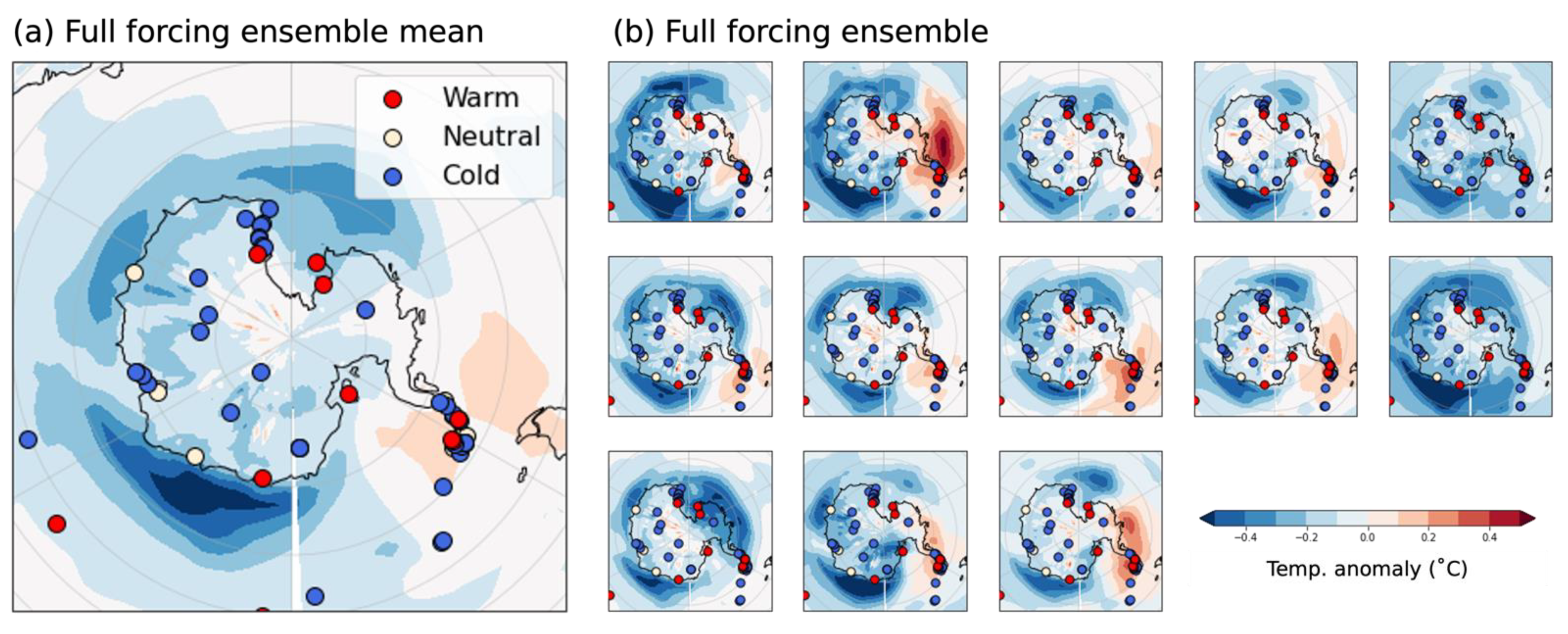
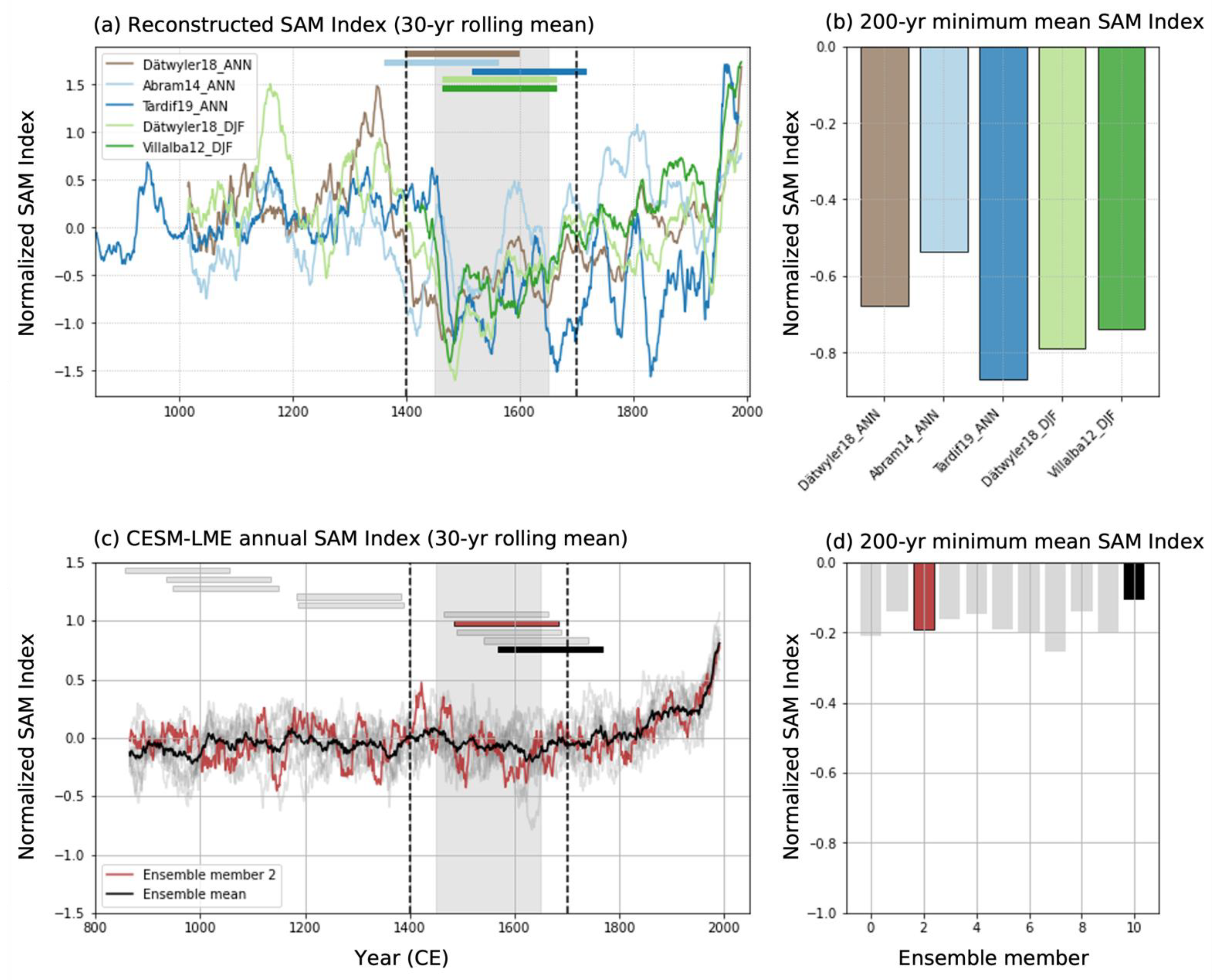
Publisher’s Note: MDPI stays neutral with regard to jurisdictional claims in published maps and institutional affiliations. |
© 2022 by the authors. Licensee MDPI, Basel, Switzerland. This article is an open access article distributed under the terms and conditions of the Creative Commons Attribution (CC BY) license (https://creativecommons.org/licenses/by/4.0/).
Share and Cite
Truax, O.J.; Otto-Bliesner, B.L.; Brady, E.C.; Stevens, C.L.; Wilson, G.S.; Riesselman, C.R. Drivers of Last Millennium Antarctic Climate Evolution in an Ensemble of Community Earth System Model Simulations. Geosciences 2022, 12, 299. https://doi.org/10.3390/geosciences12080299
Truax OJ, Otto-Bliesner BL, Brady EC, Stevens CL, Wilson GS, Riesselman CR. Drivers of Last Millennium Antarctic Climate Evolution in an Ensemble of Community Earth System Model Simulations. Geosciences. 2022; 12(8):299. https://doi.org/10.3390/geosciences12080299
Chicago/Turabian StyleTruax, Olivia J., Bette L. Otto-Bliesner, Esther C. Brady, Craig L. Stevens, Gary S. Wilson, and Christina R. Riesselman. 2022. "Drivers of Last Millennium Antarctic Climate Evolution in an Ensemble of Community Earth System Model Simulations" Geosciences 12, no. 8: 299. https://doi.org/10.3390/geosciences12080299
APA StyleTruax, O. J., Otto-Bliesner, B. L., Brady, E. C., Stevens, C. L., Wilson, G. S., & Riesselman, C. R. (2022). Drivers of Last Millennium Antarctic Climate Evolution in an Ensemble of Community Earth System Model Simulations. Geosciences, 12(8), 299. https://doi.org/10.3390/geosciences12080299






